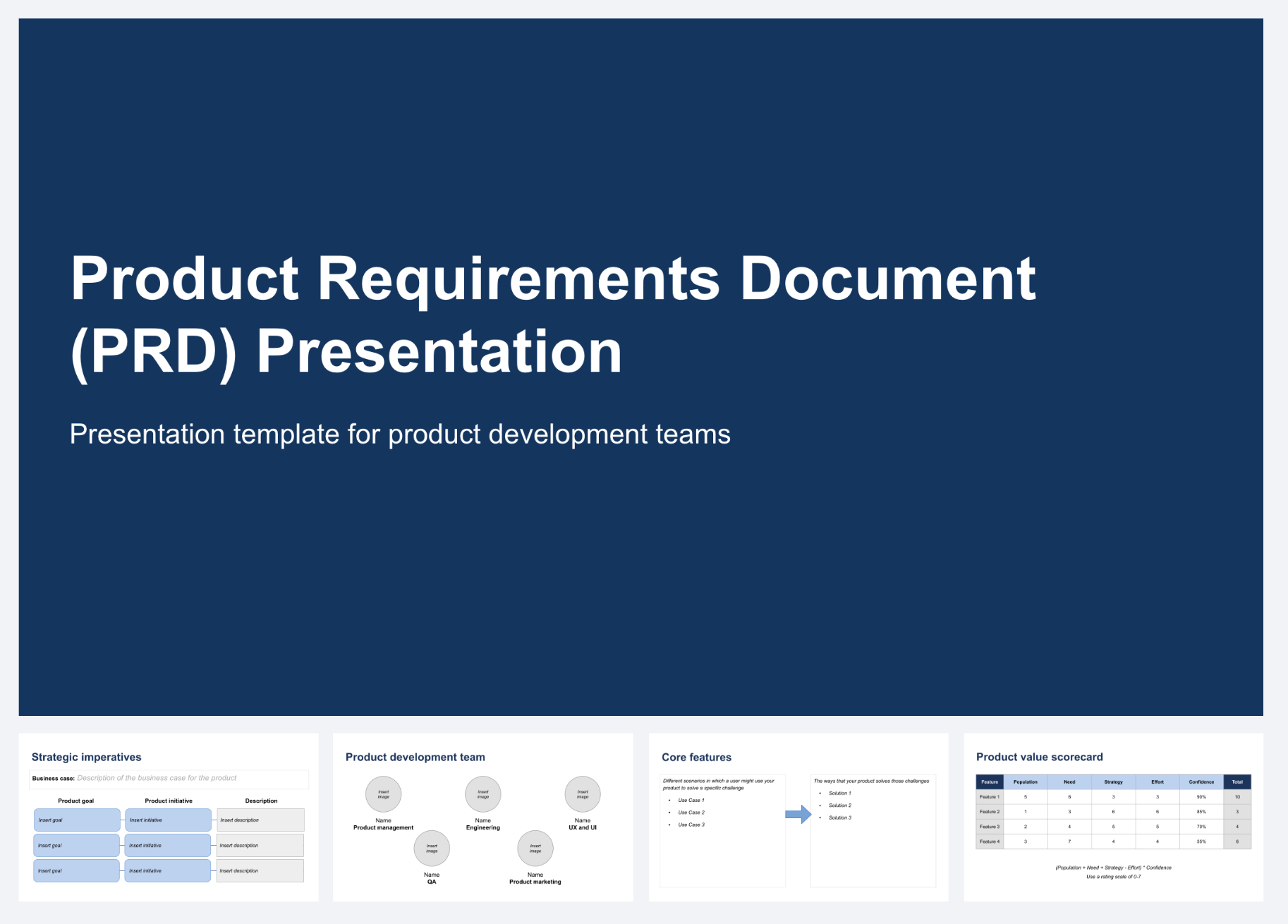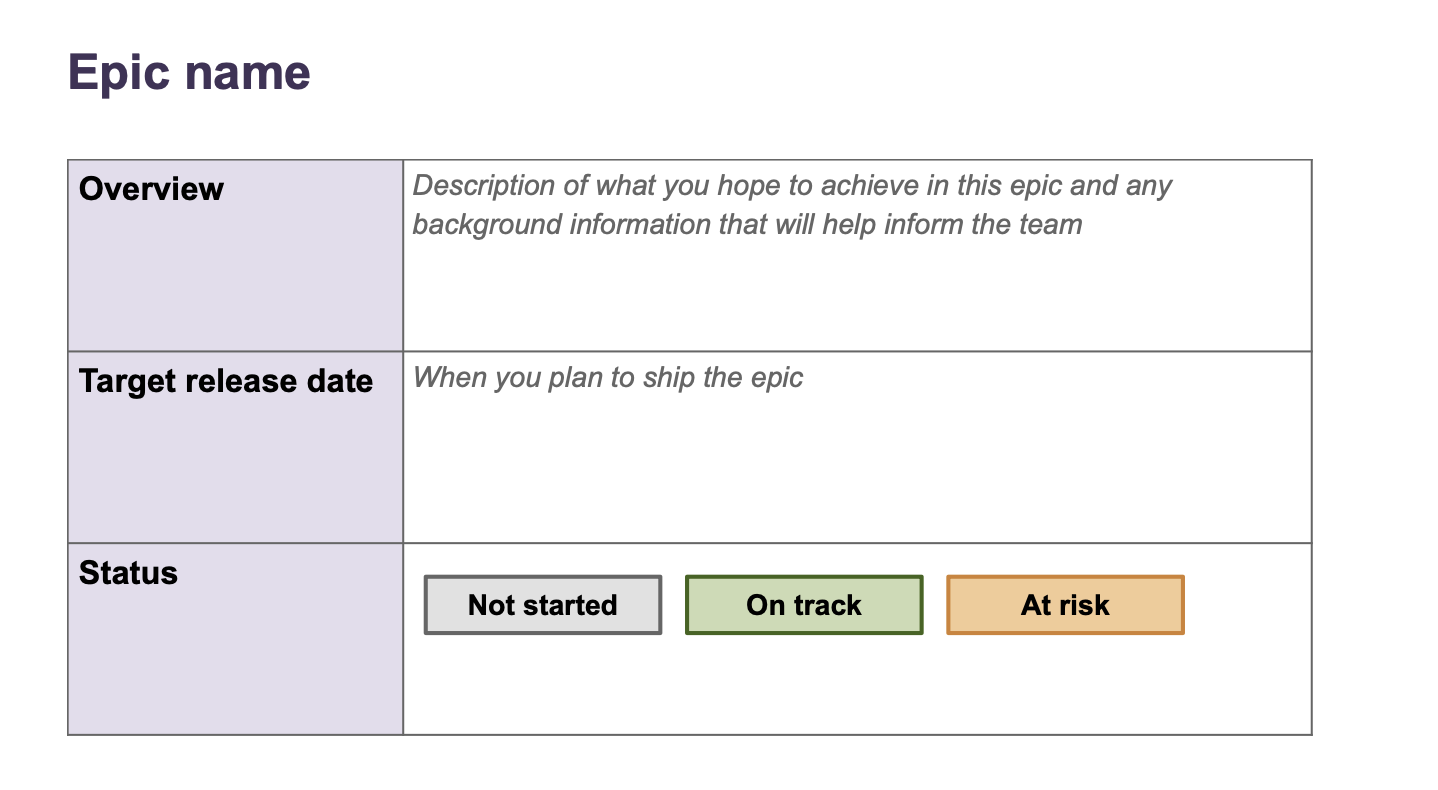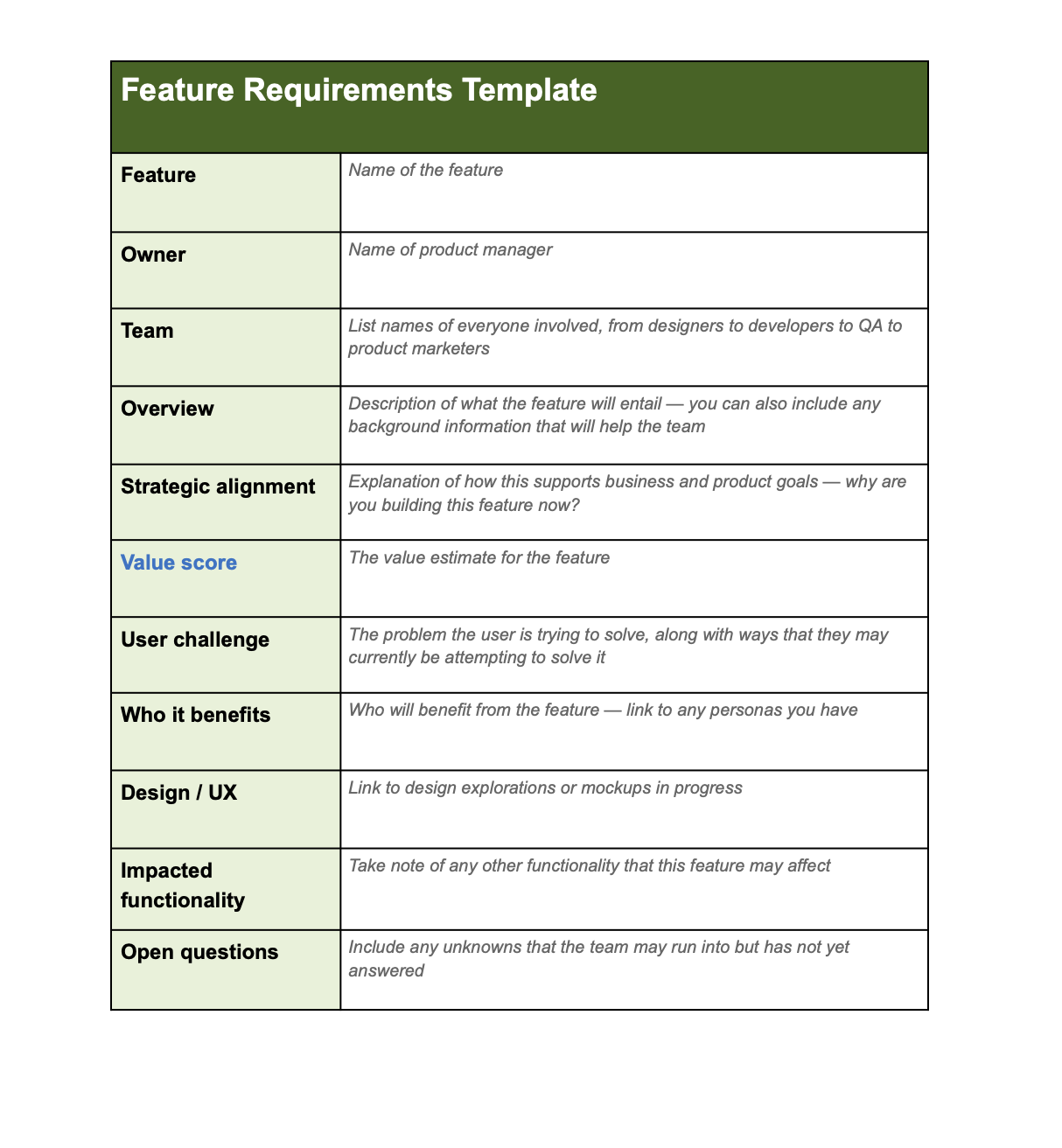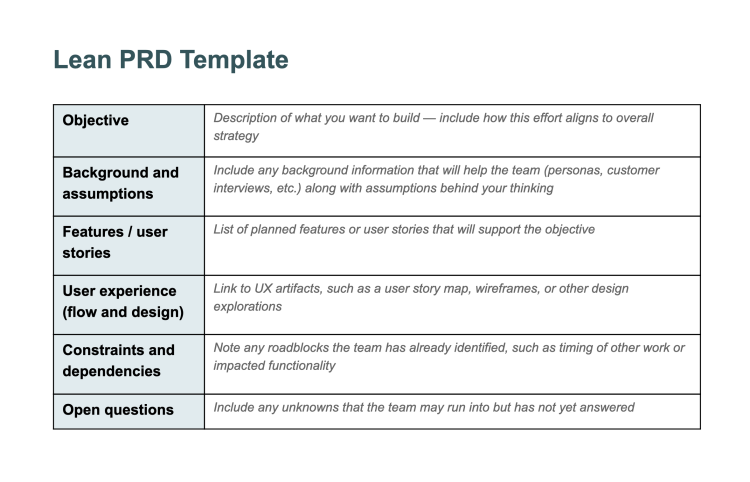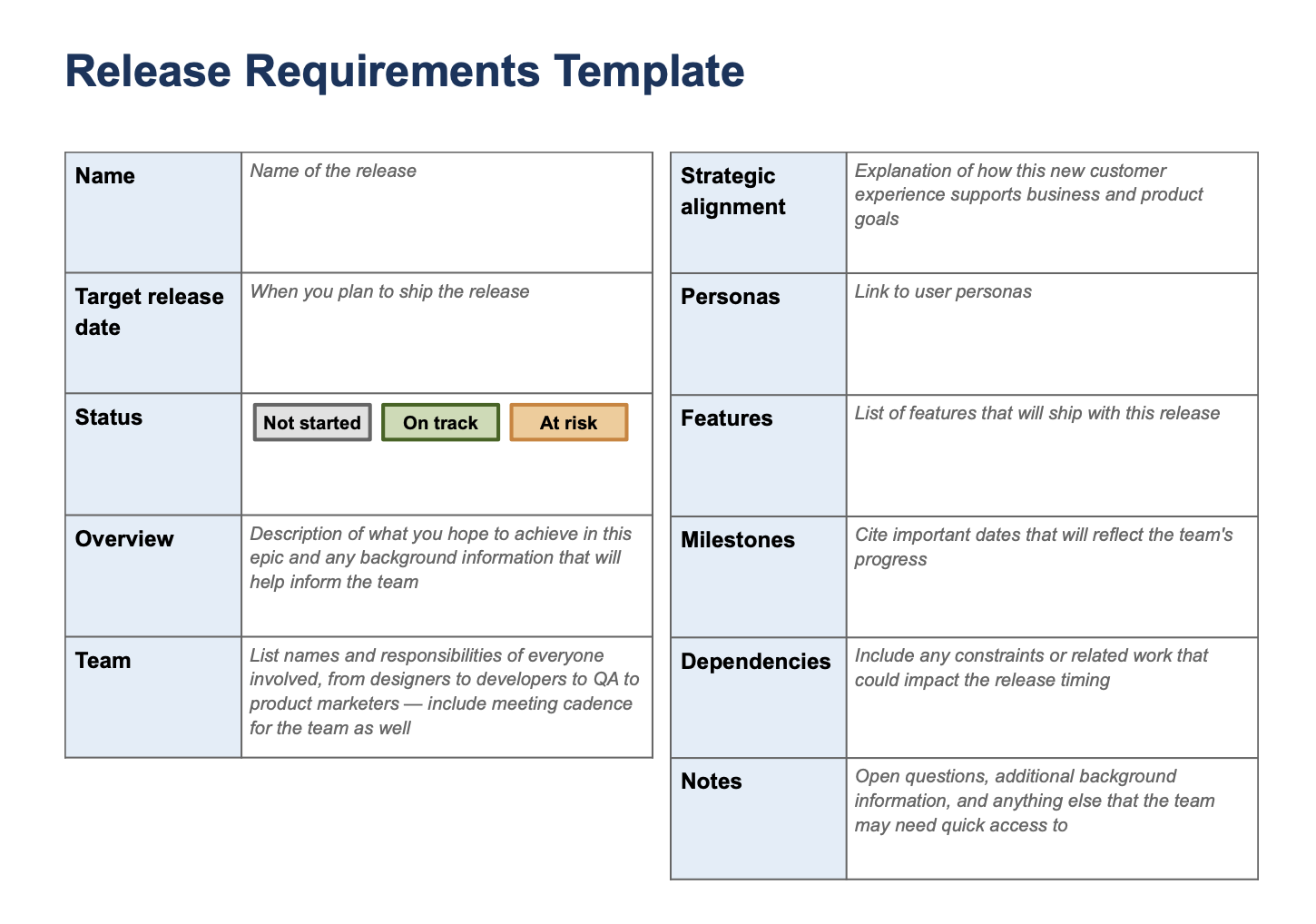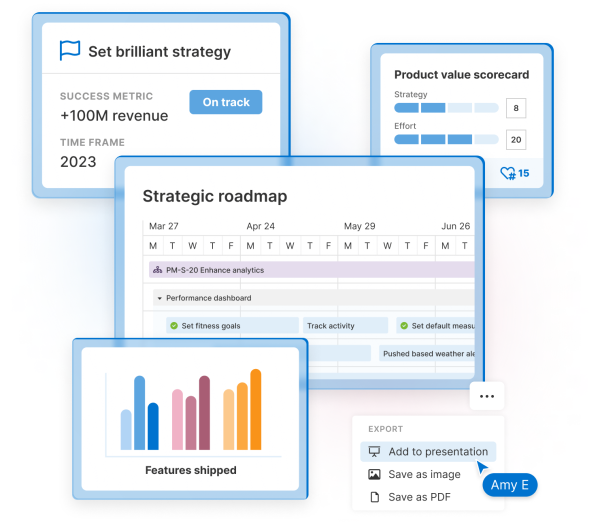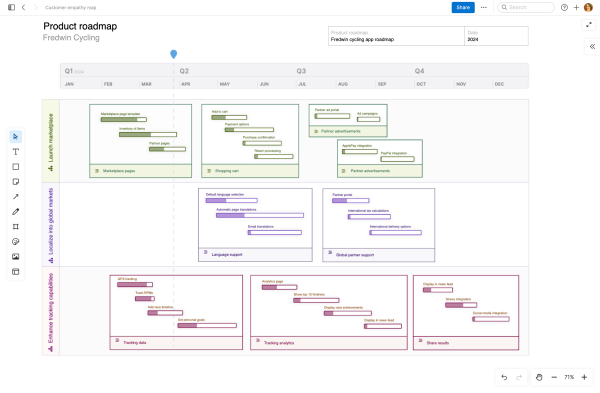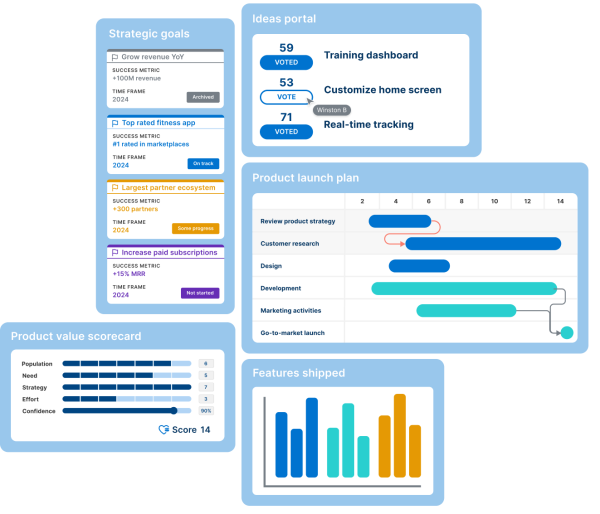PRD templates for product managers
Last updated: March 2024
A product requirements document (PRD) outlines the requirements of a product — helping your development team understand the purpose and functionality behind the build. A PRD is typically drafted by a product manager before the team begins work. The goal is to communicate what you are building, who it is for, and how it will deliver value to end users and the business.
There are still some industries where comprehensive PRDs are beneficial and even required. But it is worth noting that today few product development teams rely on the lengthy PRDs of old — most choose leaner versions of the waterfall relics. Though the majority of product builders are no longer encumbered by maintaining long-form documentation, we all need to define what it is we are building and give stakeholders needed insight.
If you use Aha! software, there are multiple ways to manage your PRDs. You can capture them in a shareable note template or embed requirements directly in work items on your product roadmap in Aha! Roadmaps. You can also use the downloadable Excel, PowerPoint, and Word formats found in this guide.
Start with our PRD note template — with a free trial.
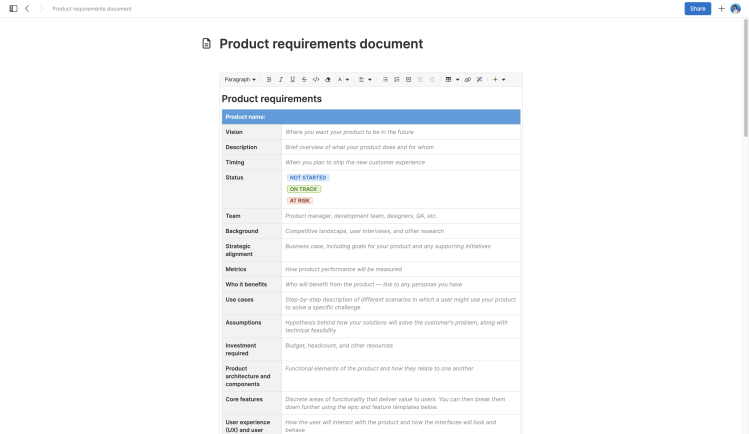
Now, let’s jump into some of the questions that led you here. What are the pros and cons of working off a PRD? How do agile teams think about product requirements? What is the best way to approach writing requirements for developers? And which PRD templates should you choose from? Use the following links to jump ahead to a specific section:
Pros and cons of a product requirements document
A product requirements document done well increases productivity and encourages cross-functional alignment — enabling deep collaboration on strategic planning and reducing time spent on version control for requirements, roadmaps, and other documentation.
Benefits of product requirements documents
The main benefit of a PRD is that it is a single source of truth. It outlines capabilities that will be delivered in a new product or release. The core product development team — along with support, sales, and marketing — will all need to know this information to effectively collaborate and deliver a Complete Product Experience (CPE) that delights customers and makes an impact on the business.
Creating, gathering input, and refining a PRD as you learn new information is a shared process that encourages cross-functional understanding and engagement — even if product managers are typically responsible for owning the document itself.
Pros of a PRD:
Outlines high-level direction for the product
Avoids assumptions about goals and scope of work
Documents timelines and areas of ownership
Details desired functionality and user experience
Provides needed context for cross-functional teams
Challenges with product requirements documents
If you speak to most product folks you will probably find that they loved puzzles or taking apart (hopefully also putting back together) household items as children. You have to be curious about how things work in order to be passionate about making new things that perform even better.
For a long time, that kind of curiosity was encouraged only before development began. The waterfall promise of a PRD was that you do all of the research and evaluation in order to evade costly surprises. But the rapid pace of development in software makes waiting a risk. Nowadays product teams prioritize speed to market and iterative improvement that incorporates real user feedback.
Criticism of the old-school PRD was often warranted. The main challenge cited was the unwieldiness of information and rigidity of its application — teams often were discouraged from pursuing ideas not outlined in the PRD. It could also be a scapegoat when the final product did not meet customer expectations. (“Well, we built what was in the requirements…”)
Video tutorial: How to keep product managers and engineers in sync
You cannot know what you do not yet know. A more modern approach to PRDs allows for the document to evolve along with the development process. Rather than prescribe exact product functionality and interactions, the goal is to inspire and guide product developers with enough information to create elegant solutions to customer problems.
Cons of a PRD:
Requires experience to write effectively
Limits creativity if seemingly handed down “from above”
Becomes irrelevant if teams are not engaged

Related:
Components of a product requirements document
What does a PRD look like? Well, it depends — on a lot. From the industry to maturity of the organization's development process to the product itself, requirements gathering and documentation is impacted by a variety of factors. We put together a few examples of different types of PRDs below, so you can get a sense of what to expect.
As you grow in your career and move to new organizations, you will undoubtedly see many different PRD formats. And you might even have the opportunity to create your own PRD templates. But there is no substitute for hands-on experience as a product manager. The more that you are exposed to professionally — positive or negative — the more that you learn. Those collective learnings will help you write more effective PRDs. It helps to have a firm understanding of the most common elements of a PRD.
PRDs typically contain some or all of the following:
Overview: The basics of what you are building, including status, team members, and release date.
Objective: Strategic alignment, including organizational goals or initiatives.
Context: Customer personas, use cases, competitive landscape, and other supporting material that will help the team develop a deeper understanding.
Assumptions: Anything that might impact product development positively or negatively, along with how you will validate, and any known dependencies.
Scope: What is a current priority and what will not be included now, but may be in a future release.
Requirements: Details of what should be built, such as user stories or wireframes.
Performance: Metrics for success.
Open questions: Anything the team anticipates or is unsure of yet how to answer.
Earlier in this guide you saw an example of a PRD note template. In comparison, we have included a custom feature description from Aha! Roadmaps below. This is another approach to sharing requirements with your development team — these records in Aha! can be directly linked to strategic goals, initiatives, and other records to give everyone on the team full context into what the work entails and why it matters.
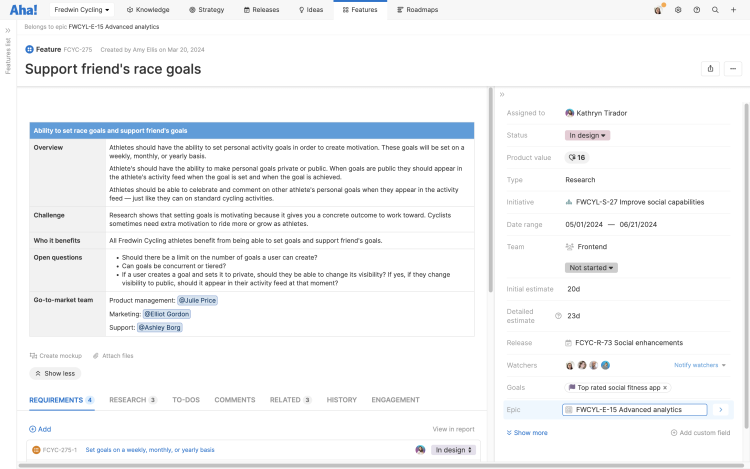
Best practices for agile requirements
Empathy is the backbone of successful product development. In an agile environment — particularly if you are working within a strict methodology — empathy is critical. You need to have empathy for your teammates and for your users. This extends to how you produce and share requirements.
Agile teams usually work from themes, epics, user stories, and tasks. Together, the first three comprise much of what you would find in a PRD. Themes represent a strategic initiative — or collection of epics that align to a shared goal. Epics are large bodies of work. And user stories are short requirements written from the perspective of the end user. (As a [type of user], I want to [perform some task] so that I can [achieve some goal].)
In the example below, an epic includes multiple features or user stories — all of these work items are linked to the goal and initiative that they support.
Epics are a container for related user stories. Stories are specific functionality that must be possible for the epic to be realized. Both are requirements, in their own way. A healthy approach to agile requirements gathering and management will look something like this:
Epics provide needed context
User stories are succinct
Product owners gather input from the team before writing
Stakeholders are involved early and often
Everyone is informed when updates happen
Backlog prioritization sessions are collaborative
10 steps to create an effective product requirements document
The “Goldilocks principle” is a good one to follow when creating a PRD. Drawn from the children’s story about the three little bears, this refers to the idea that the best solution offers just the right amount — not too much and not too little.
We find that steps below provide a repeatable structure and process for writing a PRD, regardless of how much detail you ultimately include. Here we are taking you through a release as an example. But you can swap out that word for whatever it is you are working on, whether it is an entire product or a significant new feature.
1. Define the basics
What are you building? What is the “elevator pitch” for this release?
Who is on the team? Who are the product managers, developers, and stakeholders?
When is the target release date?
What is the current status? On track, at risk, blocked?
2. Capture strategy
What are you trying to achieve with this release? What is the value you expect it to create?
How does this support business and product goals?
3. Offer context
What does the team need to know to do their job successfully?
What informed this release? Was it a market trend? Do you have customer interviews to share?
Who are your target personas? What use cases have you identified?
Is there high-level information about future roadmap plans worth sharing?
4. List assumptions
What hypotheses have you made — business, technical, resourcing, etc?
How might these assumptions affect product development?
5. Detail requirements
What problems are you trying to solve? What functionality must be included?
What features or user stories will be shipped in this release? What is the priority level of those?
6. Include design
What will the product look and feel like? How will the user interact with the features in this release?
Do you have wireframes or mockups to share? Can you provide links to existing design explorations that will inspire the team?
7. Provide metrics
What metrics and KPIs will you track?
How will you determine the value of what you deliver?
8. Consider impact
Are there known dependencies?
What other areas of the product will this release affect?
What level of ongoing maintenance will be needed? Support?
Are other teams needed?
9. Outline scope
What is not included in this release?
10. Make room for questions
What questions can you anticipate? Are there any outstanding without answers yet? What additional research will you need to complete?
Related:
PRD templates
By now you are well aware that PRDs are situational. There is no one ideal PRD template. The best product managers will tweak any template to best fit your product and organization. But if you are looking for a downloadable template, we have pulled a few together. (When you are done with these, you can upgrade to an Aha! template.)
PRD presentation template
There are times when you need a comprehensive overview so that everyone can understand what that product will do. You might be releasing a new offering or shipping a major update to an existing one. Because of the broad impact of the work ahead, product development teams typically need to present critical details to executives, partners, or other stakeholders. You want to showcase your product vision, your assumptions, and your plans to deliver value.
The presentation template download below includes a wide range of product information that you may want to capture. The text prompts indicate what level of detail you will want to include — but you can always add more or less.
If your organization already has a branded presentation theme then you can use the table of PRD elements to build out your own slide deck:
Product name | This one should be obvious |
Vision | Where you want your product to be in the future |
Description | Brief overview of what your product does and for whom |
Team | Product manager, development team, designers, QA, etc. |
Timing | Target release date |
Status | Indication of current progress, such as "on track" or "at risk" |
Background | Competitive landscape, user interviews, and other research |
Strategic imperatives | Business case, including goals for your product and any supporting initiatives |
Metrics | How product performance will be measured |
Personas | Semi-fictional archetype that represents traits and behaviors of prospective customers |
Use cases | Step-by-step description of different scenarios in which a user might use your product to solve a specific challenge |
Assumptions | Hypothesis behind how your solutions will solve the customer's problem, along with technical feasibility |
Investment required | Budget, headcount, and other resources |
Product architecture and components | Functional elements of the product and how they relate to one another |
Core features | Discrete areas of functionality that deliver value to users |
User experience (UX) and user interface (UI) | How the user will interact with the product and how the interfaces will look and behave |
Acceptance criteria | Conditions that must bet met for the product to be accepted by the user or other systems |
Scope | What will not be built at this time (ideas gleaned during development can be save for future) |
Open questions | Any questions the team may have — whether answers yet exist or not |
Agile PRD template
It is true that agile teams may not practice requirements gathering in a highly detailed way. But there is still a benefit to documenting and sharing the essence of what you are building. Agile product development teams usually work from themes, epics, user stories, and tasks. PRDs cover what a product should do. So when you are looking for an agile PRD template, it makes sense that you would focus on the most pertinent elements related to what you will build:
Epic name | Name of epic |
Overview | Description of what you hope to achieve in this epic and any background information that will help inform the team |
Target release | When you plan to ship the epic |
Status |
|
Owner | Name of product owner |
Designer | Name of UX and UI designer |
Developers | Names of developers or development team |
QA | Names of QA managers or QA team |
Strategic alignment | Brief explanation of how this supports business and product goals |
User stories | List of user stories |
Open questions | Anything the team has not yet answered |
This is a basic template for listing user stories.
Epic | User story | Description | Priority | Notes |
Name of the epic that the user story belongs to | As a [type of user], I want to [perform some task] so that I can [achieve some goal]. | Be succinct |
| Provide any additional context or include open questions |
<insert here> | <insert here> | <insert here> | <insert here> | <insert here> |
<insert here> | <insert here> | <insert here> | <insert here> | <insert here> |
Feature requirements template
Products are comprised of many features. And as you continue to evolve and improve your offering, a lot of the product development team's time will be spent delivering feature-level work. Writing detailed feature requirements is an essential part of a product manager's work. You want to be sure to give the engineering team enough detail to avoid surprises later on — but not so much that they feel constrained. The benefit extends beyond the core development team too. Having feature requirements captured in a concise template is helpful for cross-functional teams who will support the launch of new functionality.
Feature | Name of the feature |
Owner | Name of product manager |
Team | List names of everyone involved, from designers to developers to QA to product marketers |
Overview | Description of what the feature will entail — you can also include any background information that will help the team |
Strategic alignment | Explanation of how this supports business and product goals — why are you building this feature now? |
Value score | The value estimate for the feature |
User challenge | The problem the user is trying to solve, along with ways that they may currently be attempting to solve it |
Who it benefits | Who will benefit from the feature — link to any personas you have |
Design / UX | Link to design explorations or mockups in progress |
Impacted functionality | Take note of any other functionality that this feature may affect |
Open questions | Anything the team has not yet answered |
Lean PRD template
The goal of lean product development is to avoid the waste typically associated with top-heavy processes. Instead of separating the various groups involved with delivering a new user experience, lean practices put an emphasis on organizing around a core team who have a deep understanding of what customer and business needs. Naturally, lean teams choose a streamlined approach to requirements gathering:
Objective | Description of what you want to build — include how this effort aligns to overall strategy |
Background and assumptions | Include any background information that will help the team (personas, customer interviews, etc.) along with assumptions behind your thinking |
Features / user stories | List of planned features or user stories that will support the objective |
User experience (flow and design) | Link to UX artifacts, such as a user story map, wireframes, or other design explorations |
Constraints and dependencies | Note any roadblocks the team has already identified, such as timing of other work or impacted functionality |
Open questions | Include any unknowns that the team may run into but has not yet answered |
Release requirements template
A release is more than the bits of code that the team writes and ships. It is the opportunity to deliver a new customer experience — from the new functionality to the way that cross-functional teams support the go-to-market launch and beyond. With so many folks contributing to product success, it is critical to consider all of the elements that will impact your release (updating as progress happens to reflect the latest):
Name | Release name |
Target release date | When you plan to ship the new customer experience |
Status |
|
Overview | Description of what you hope to achieve in this epic and any background information that will help inform the team |
Team | List names and responsibilities of everyone involved, from designers to developers to QA to product marketers — include meeting cadence for the team as well |
Strategic alignment | Explanation of how this new customer experience supports business and product goals |
Personas | Link to user personas |
Features | List of features that will ship with this release |
Milestones | Cite important dates that will reflect the team's progress |
Dependencies | Include any constraints or related work that could impact the release timing |
Notes | Open questions, additional background information, and anything else that the team may need quick access to |
The templates above are a good start for small teams. If you find that you outgrow them, consider using Aha! Roadmaps — where you can set product strategy, build visual plans, write user stories, and update documentation all in one place.

